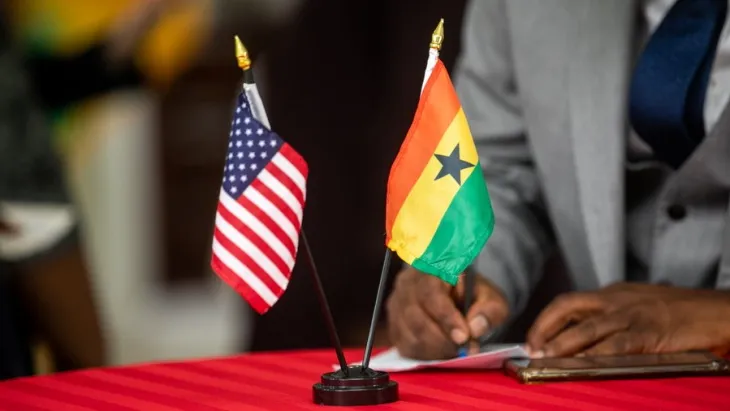The recent imposition of sweeping tariffs by the Trump Administration on imports has sent ripples across the global trade landscape. This reciprocal tariff structure, designed to counter taxes levied on US goods by other nations, has impacted countries worldwide, albeit with varying degrees of severity. Ghana, while included in the affected nations, experienced a relatively lighter touch, falling into the lowest baseline tariff bracket of 10%, a category shared with the United Kingdom. This stands in contrast to some countries facing tariffs exceeding 40%, highlighting a degree of leniency towards Ghana in the US policy shift. While this development undoubtedly presents challenges for Ghanaian businesses exporting to the US, the actual depth of the cut on Ghana’s overall export figures warrants closer examination.
A deeper dive into the trade relationship between the US and Ghana reveals a relatively modest volume of trade. Data from Trend Economy indicates that the US accounts for a mere 4.6% of Ghana’s total exports, less than 5% of the country’s export portfolio. This is further corroborated by the Ghana Statistical Service, which excludes the US from Ghana’s top five export destinations. The lion’s share of Ghana’s exports is directed towards the United Arab Emirates, Switzerland, South Africa, the Netherlands, and India, collectively accounting for approximately 64.4% of total exports. The remaining 35.6% is distributed among all other export destinations, including the US. This data paints a picture of a US market that, while present, is not a dominant force in Ghana’s export strategy. Ghana’s primary exports to the US consist of crude petroleum, cocoa beans, and cocoa paste, while imports from the US include vehicles, refined and crude petroleum, rubber, soybeans, and raw lead, amongst other goods. In 2024, the total bilateral trade value reached $2.1 billion, with $1.2 billion representing imports from Ghana to the US and $967 million representing exports to Ghana, resulting in a trade deficit of $204 million for the US.
Despite the relatively low trade volume between the two nations, the tariff hike does pose potential challenges for Ghanaian exporters. The ad valorem nature of the tariff, paid by importers at US ports and subsequently passed on to consumers, will inevitably increase the price of Ghanaian goods in the US market. This price increase can erode the competitiveness of Ghanaian products against similar goods from countries not subject to the tariffs, potentially dampening demand. This scenario raises concerns about possible trade diversion, where US importers may seek alternative sources for goods previously sourced from Ghana, impacting Ghanaian businesses and potentially leading to job losses within the affected sectors.
The decline in demand resulting from increased prices could significantly impact the revenue of Ghanaian businesses reliant on the US market. Sectors such as cocoa processing, shea butter production, and handicrafts, among others, are particularly vulnerable to this potential disruption. Furthermore, the tariff hike can disrupt existing supply chains, forcing Ghanaian exporters to reassess their pricing strategies and logistics networks. These adjustments could lead to increased costs, further squeezing profit margins and adding pressure to already vulnerable businesses.
In the face of these potential challenges, Ghanaian exporters can adopt several remedial measures to navigate the changing trade landscape. Diversifying export destinations is a crucial strategy. Given the relatively small proportion of exports directed to the US, strengthening trade relationships with existing major partners like Switzerland, South Africa, UAE, China, and India, and exploring new emerging markets with favorable trade agreements, can help offset potential losses in the US market. Leveraging existing trade agreements, such as the African Continental Free Trade Area (AfCFTA) to boost intra-African trade, and the African Growth and Opportunity Act (AGOA) for duty-free access to the US market for specific products, can further mitigate the impact of the tariffs.
Enhancing productivity and cost efficiency within Ghana’s export sectors is another critical adaptation strategy. Investing in modern processing techniques, automation, and streamlined supply chain management can help reduce production and logistics costs, enabling Ghanaian businesses to remain competitive despite the tariff-induced price increases. Governmental intervention also plays a vital role. Diplomatic negotiations with the US to secure tariff exemptions for key industries, coupled with providing financial incentives, subsidies, or export credit facilities to affected businesses, can help cushion the blow and support impacted sectors.
The overall macroeconomic impact of the US tariff hike on Ghana is likely to be contained, considering the relatively small proportion of Ghanaian exports destined for the US market. However, specific industries and businesses heavily reliant on US trade will undoubtedly feel the impact more acutely. While the tariff hike presents an immediate challenge, its long-term implications for Ghana’s overall economy are likely to be limited. Secondary effects, such as increased input costs from countries like China, whose own trade with the US might be affected by the tariffs, could have broader inflationary implications for Ghana.
In conclusion, while the US tariff hike presents a hurdle for Ghanaian exporters, it is not an insurmountable obstacle. By embracing a proactive and adaptive approach, focusing on diversification, adding value to exports, improving efficiency, and strategically leveraging trade agreements, Ghanaian businesses can navigate this challenge effectively. Coupled with supportive government intervention and private sector resilience, Ghana’s export sector can weather the storm and continue its growth trajectory despite the shifting global trade dynamics.


